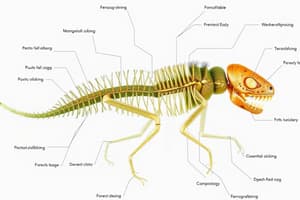Podcast
Questions and Answers
What is the primary role of taxonomy in biology?
What is the primary role of taxonomy in biology?
- To analyze evolutionary relationships between organisms
- To study the genetic makeup of organisms
- To classify and name organisms (correct)
- To explore the environmental impact of species
Which system did Linnaeus develop for naming organisms?
Which system did Linnaeus develop for naming organisms?
- Polytypic nomenclature
- Binomial nomenclature (correct)
- Monomial nomenclature
- Trinomial nomenclature
What is a limitation of the two-kingdom classification system?
What is a limitation of the two-kingdom classification system?
- It provides too much detail about organism classification.
- It fails to account for the diversity of microorganisms. (correct)
- It effectively groups all organisms into classes.
- It simplifies the classification of kingdoms into generas.
Which of the following best describes the three-domain system?
Which of the following best describes the three-domain system?
What characteristic is NOT typically used to differentiate the Bacteria domain from Archaea?
What characteristic is NOT typically used to differentiate the Bacteria domain from Archaea?
What is the main purpose of Bergey's Manual?
What is the main purpose of Bergey's Manual?
Which of the following terms denotes an interbreeding group of organisms that produces viable offspring?
Which of the following terms denotes an interbreeding group of organisms that produces viable offspring?
Which method is used for differentiating microorganisms through genetic analysis?
Which method is used for differentiating microorganisms through genetic analysis?
How does a cladogram differ from a dichotomous key?
How does a cladogram differ from a dichotomous key?
Which test result is notable for identifying Citrobacter freundii?
Which test result is notable for identifying Citrobacter freundii?
What is the significance of a positive Lactose test in this context?
What is the significance of a positive Lactose test in this context?
Which of the following sugars is not mentioned in connection with Citrobacter freundii?
Which of the following sugars is not mentioned in connection with Citrobacter freundii?
Which amino acid is included in the test group related to Citrobacter freundii?
Which amino acid is included in the test group related to Citrobacter freundii?
In the context of the given tests, which result suggests the fermentation capability of the organism?
In the context of the given tests, which result suggests the fermentation capability of the organism?
What aspect of the biochemical testing is crucial for determining Citrobacter freundii?
What aspect of the biochemical testing is crucial for determining Citrobacter freundii?
Which sugar test would likely show a negative result for Citrobacter freundii?
Which sugar test would likely show a negative result for Citrobacter freundii?
What role does H2 S play in the testing of Citrobacter freundii?
What role does H2 S play in the testing of Citrobacter freundii?
Which of the following tests would most likely yield a positive result for Citrobacter freundii?
Which of the following tests would most likely yield a positive result for Citrobacter freundii?
Which test is typically used to differentiate among Enterobacteriaceae, including Citrobacter freundii?
Which test is typically used to differentiate among Enterobacteriaceae, including Citrobacter freundii?
What is a strain in microbiology?
What is a strain in microbiology?
Which kingdoms were originally proposed by Linnaeus?
Which kingdoms were originally proposed by Linnaeus?
What is the primary basis for Whittaker's five-kingdom classification system?
What is the primary basis for Whittaker's five-kingdom classification system?
Which of the following is NOT one of the three domains proposed by Carl Woese?
Which of the following is NOT one of the three domains proposed by Carl Woese?
What type of testing method utilizes an organism's ability to ferment carbohydrates?
What type of testing method utilizes an organism's ability to ferment carbohydrates?
In microbiology, which characteristic refers to the arrangement and shape of cells?
In microbiology, which characteristic refers to the arrangement and shape of cells?
Which method is described as using a single tube containing media for multiple biochemical tests?
Which method is described as using a single tube containing media for multiple biochemical tests?
Which of the following microorganism groups does NOT fit under the kingdom Fungi?
Which of the following microorganism groups does NOT fit under the kingdom Fungi?
What key component differentiates Archaea from Bacteria?
What key component differentiates Archaea from Bacteria?
Which classification method is utilized primarily for identifying prokaryotes?
Which classification method is utilized primarily for identifying prokaryotes?
What is the primary function of antibodies in the immune response?
What is the primary function of antibodies in the immune response?
Which method involves the use of a labeled antibody to detect specific antigens?
Which method involves the use of a labeled antibody to detect specific antigens?
In nucleic acid analysis, what does the G+C ratio indicate?
In nucleic acid analysis, what does the G+C ratio indicate?
What is the primary purpose of a dichotomous key in microbiology?
What is the primary purpose of a dichotomous key in microbiology?
Which technique allows for the amplification of DNA from microorganisms that cannot be cultured?
Which technique allows for the amplification of DNA from microorganisms that cannot be cultured?
What characteristic is shared by microorganisms classified as antigenic?
What characteristic is shared by microorganisms classified as antigenic?
The primary output of a slide agglutination test is:
The primary output of a slide agglutination test is:
What does the method of DNA fingerprinting primarily analyze?
What does the method of DNA fingerprinting primarily analyze?
In the context of serological tests, what does the term 'specificity' refer to?
In the context of serological tests, what does the term 'specificity' refer to?
Which bacterial species listed in the activity is gram positive and rod-shaped?
Which bacterial species listed in the activity is gram positive and rod-shaped?
Flashcards are hidden until you start studying
Study Notes
Taxonomy and Classification
- Taxonomy involves the classification and naming of organisms.
- It includes systematics, which studies the evolutionary history (phylogeny) of organisms.
- A taxon refers to a specific group of organisms, while phylogeny is the evolutionary lineage leading to that group.
Historical Contributions
- Carl Linnaeus: Developed binomial nomenclature as a two-part naming system using Latin; first part is the genus, second part is the species epithet.
- Examples: Escherichia coli, Vibrio cholerae.
- Established a taxonomic hierarchy: species, genus, family, order, class, phylum, kingdom.
- Robert Whittaker: Introduced a five-kingdom classification system, expanding upon Linnaeus's two kingdoms to include Monera, Protista, Fungi, Plantae, and Animalia.
- Carl Woese: Proposed the three-domain system (Eukarya, Bacteria, Archaea) based on rRNA sequences.
Two-Kingdom vs. Three-Domain Systems
- Two-kingdom system: Plantae and Animalia; limited in addressing diversity.
- Three-domain system recognizes significant genetic differences among organisms, particularly prokaryotes.
Key Characteristics of Domains
- Bacteria: Prokaryotic, diverse metabolic pathways.
- Archaea: Extremophiles like methanogens, halophiles, and hyperthermophiles, distinct from bacteria.
- Eukarya: Contains all eukaryotic organisms, including plants, animals, fungi, and protists.
Scientific Naming and Major Taxa
- Scientific names provide precise identification, minimizing ambiguity.
- Major taxa include species, genus, family, order, class, phylum, and kingdom.
Cultures, Clones, and Strains
- Culture: Growth of microorganisms in a controlled environment.
- Clone: Descendants derived from a single parent cell.
- Strain: Genetic variant within a species, often with specific characteristics.
Characteristics of Multicellular Eukarya
- Eukarya are differentiated based on cell structure, reproductive strategies, and modes of nutrition (e.g., plants are autotrophic; animals and fungi are heterotrophic).
Definition of Protists
- Protists are a diverse group of mostly unicellular organisms that can be autotrophic or heterotrophic.
Distinction of Species
- Prokaryotic species consist of cells with similar characteristics, while eukaryotic species have organisms that interbreed to produce viable offspring.
Bergy’s Manual and Identification Methods
- Bergey’s Manual: A comprehensive resource aiding in prokaryotic identification.
- Identification techniques include morphology, biochemical tests, serological analysis, and nucleic acid testing.
Identification Techniques
- Biochemical Tests: Assess enzymatic activities to identify metabolic capabilities (e.g., fermentation).
- Serological Tests: Evaluate antigen-antibody reactions to identify bacteria.
- ELISA and Western blotting are common methods.
- Nucleic Acid Analysis:
- DNA base composition compares guanine-cytosine ratios.
- DNA fingerprinting analyzes restriction enzyme digest patterns.
- PCR amplifies unknown microbial DNA.
Dichotomous Keys
- Dichotomous keys guide users through a systematic process to identify organisms based on specific characteristics.
- Useful for differentiating between species using a step-by-step flowchart approach.
Practical Application
- Constructing dichotomous keys and utilizing rapid identification tests like the EnteroPluri Test for bacteria demonstrate applied taxonomy in microbiological studies.
Studying That Suits You
Use AI to generate personalized quizzes and flashcards to suit your learning preferences.




